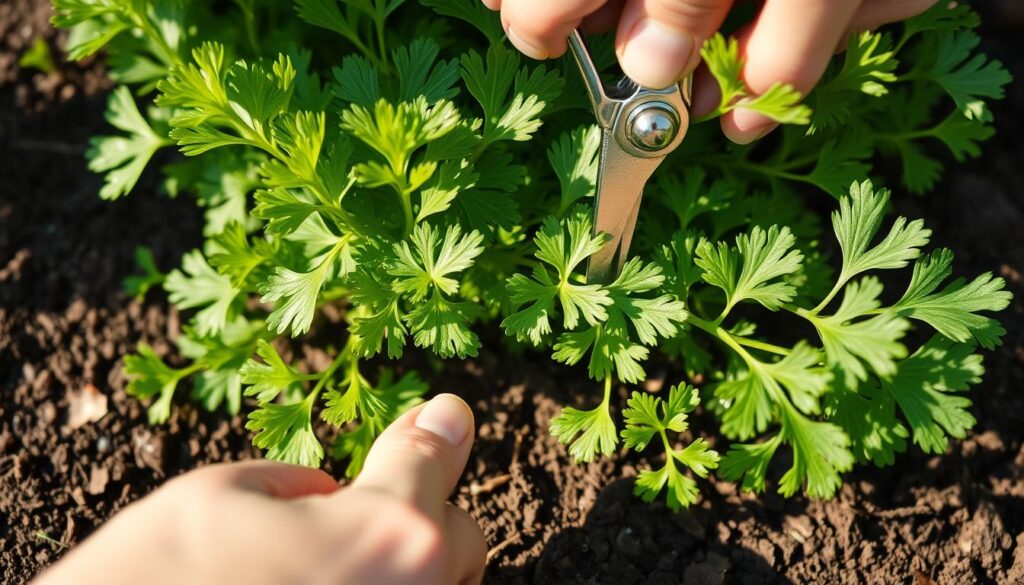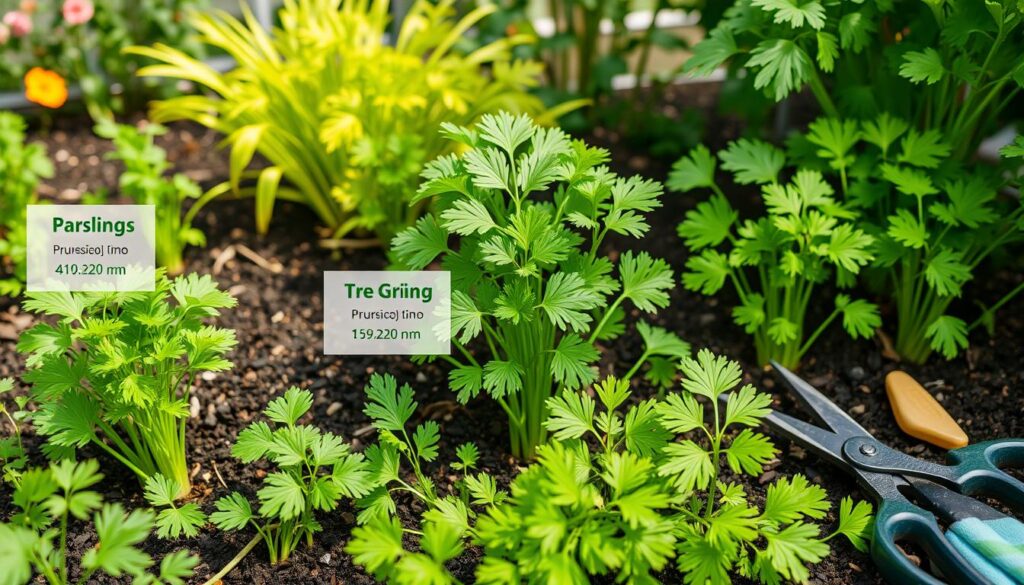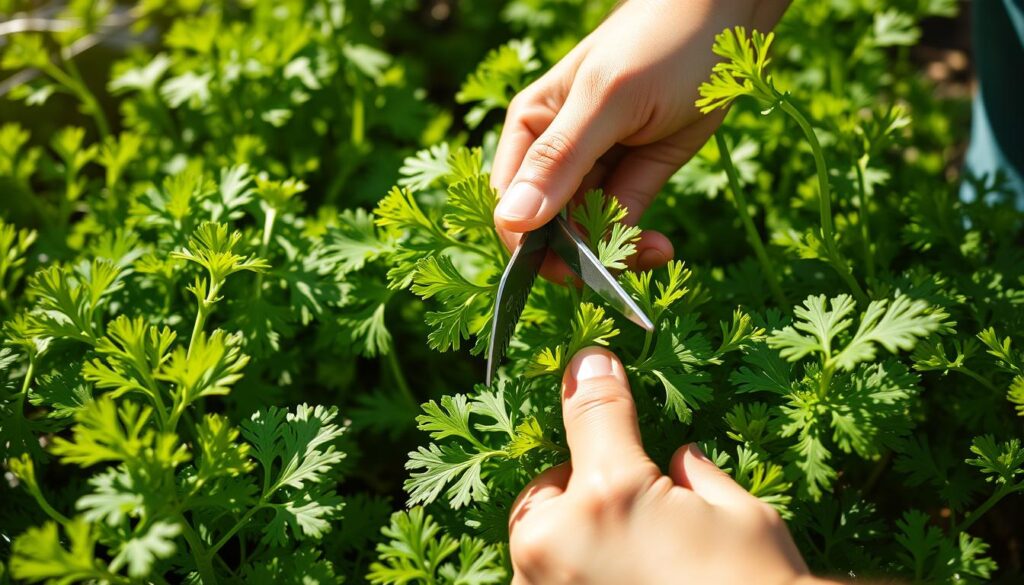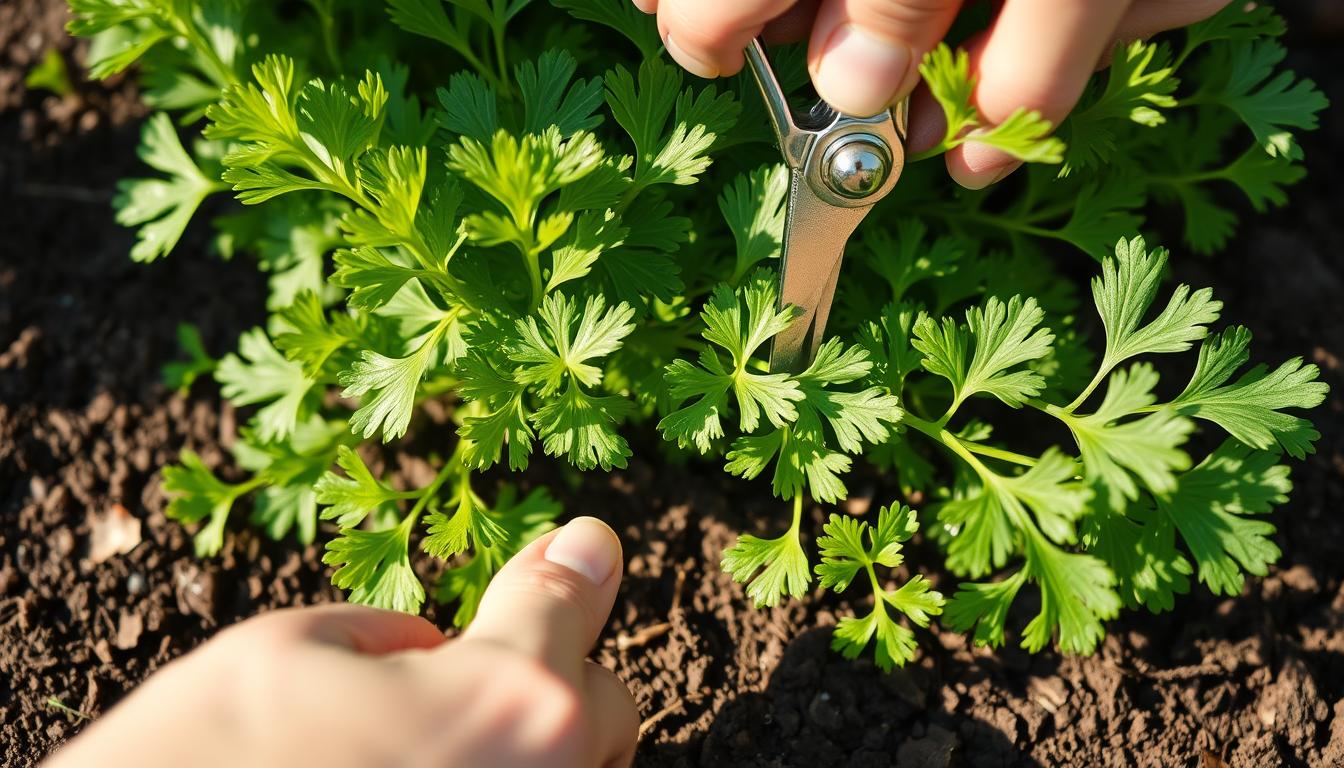I love parsley in my kitchen. It’s versatile and adds great flavor to many dishes. But did you know pruning can make your parsley plants even better?

Parsley loves the sun, some shade, and moist soil. You can start it from seed in warmer months. It also grows well indoors. The more you cut it, the healthier it gets.
By following simple steps, your parsley will stay lush and green. It’s perfect for cooking, soups, and salads. It’s also great with meat and fish, and adds flavor to dressings and sauces.
Benefits of Pruning Parsley
Pruning parsley is more than just a quick cut. It’s essential for the herb’s health. Regular trimming leads to lush, new growth, making your parsley look bushy and full. Pruning also stops parsley from flowering, which makes the leaves turn bitter and lose their flavor.
Keeping parsley fresh and aromatic is important. By cutting the right parts, you ensure your dishes have the best parsley flavor. Pruning also makes parsley more useful for garnishes, cooking, and other recipes.
Promote New Growth
Trimming parsley makes it grow more leaves, keeping it lush and full. By removing old or damaged leaves, you tell the plant to focus on growing new, fresh leaves.
Ward Off Flowering
Parsley can bolt and flower, which makes the leaves bitter. Pruning before it flowers helps keep the leaves tasty.
Maintain Flavor
Regular pruning keeps parsley leaves at their best flavor and aroma. By not letting the plant flower, it uses its energy to grow more leaves.
“Pruning parsley is key to enjoying its fresh, fragrant leaves all season long.”
When to Trim Parsley
Pruning Italian parsley is easy, but timing is everything. The best time to trim is in the spring when the plant is young. It should be about 6 inches tall and tender before it bolts and turns bitter.
Early Growth Stage
When your parsley has three sets of leaves, it’s time for a trim. Cutting the stems at this stage makes the plant bushier and prevents it from becoming leggy.
Before Bolting
Watch your parsley for signs of flowering, or “bolting.” When you see the first flower buds, it’s time to prune. Cutting it back before it bolts keeps the flavor strong.
Regular Maintenance
For the best results, prune regularly throughout the growing season. Trimming often gives you a steady supply of fresh parsley leaves. Just don’t cut more than a third of the plant at once to avoid stressing it.

Knowing when to trim parsley keeps your plants healthy and flavorful. Whether you’re pruning for growth, to prevent flowering, or for regular care, timing is everything. It’s all about when to prune parsley right.
Where to Cut Parsley
When pruning parsley, focus on the older leaves and stems. Cut at the plant’s base to encourage new growth. This keeps the herb’s flavor strong. Also, remove any flower buds quickly to prevent the plant from seeding.
Use sharp scissors or shears for clean cuts. Trim stems about an inch above the base. This helps the plant grow back. Make sure no stems block sunlight to promote even growth.
Don’t throw away the trimmed stems. They add a nice crunch to salads or flavor to stocks and soups. By following these parsley pruning tips, your parsley will grow lush and vibrant. You’ll also get the most out of your homegrown parsley.

“The best time to pick parsley is early morning when the oils in the leaves are most potent and have the best flavor.”
Techniques for Pruning Parsley
Proper pruning techniques are key for a thriving parsley plant. Learning how to prune parsley helps it grow bushier, increases harvests, and looks better.
Pinching for Bushiness
To get a fuller parsley plant, try pinching. Pinch the top of stems just above a leaf node. This makes the plant grow more side shoots, making it look lush and compact.
Cutting for Harvest
When it’s time to harvest, cut stems back to about an inch above the base. This might seem like a close shave, but it keeps leaves tender and flavorful. Longer stems can get tough and less tasty.
Shaping for Aesthetics
For a visually appealing parsley plant, use sharp scissors or pruning shears. Shape the foliage into a mound, like a mini topiary. Remove any flower buds to keep leaves flavorful and tender.
Learning parsley pruning methods and parsley pruning techniques is vital. By using these how to prune parsley strategies, you’ll get the best parsley from your garden.
Conclusion
Pruning parsley is more than just cutting off extra growth. It’s a way to help your parsley plant grow strong and tasty. By following the tips in this guide, you can make sure your parsley keeps giving you plenty of fresh leaves all season.
The key to pruning parsley is to do it at the right time. You should aim for areas that will grow new leaves. Also, use the right methods to keep your parsley looking good. With a bit of care, your parsley will grow bushy and keep producing leaves all season.
Remember, taking care of parsley is a continuous job, but it’s worth it. By using these pruning tips, you’ll always have fresh parsley leaves for your cooking. Happy pruning!









